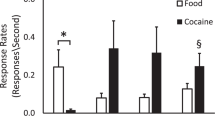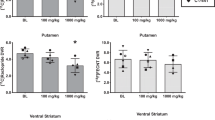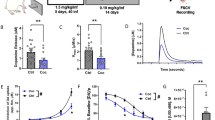Abstract
There is currently no Food and Drug Administration-approved pharmacotherapy for cocaine addiction. Monoamine releasers such as d-amphetamine constitute one class of candidate medications, but clinical use and acceptance are hindered by their own high-abuse liability. Phendimetrazine (PDM) is a schedule III anorectic agent that functions as both a low-potency monoamine-uptake inhibitor and as a prodrug for the monoamine-releaser phenmetrazine (PM), and it may serve as a clinically available, effective, and safer alternative to d-amphetamine. This study determined efficacy of chronic PDM to reduce cocaine self-administration by rhesus monkeys (N=4) using a novel procedure that featured both daily assessments of cocaine vs food choice (to assess medication efficacy to reallocate behavior away from cocaine choice and toward choice of an alternative reinforcer) and 20 h/day cocaine access (to allow high-cocaine intake). Continuous 21-day treatment with ramping PDM doses (days 1–7: 0.32 mg/kg/h; days 8–21: 1.0 mg/kg/h) reduced cocaine choices, increased food choices, and nearly eliminated extended-access cocaine self-administration without affecting body weight. There was a trend for plasma PDM and PM levels to correlate with efficacy to decrease cocaine choice such that the monkey with the highest plasma PDM and PM levels also demonstrated the greatest reductions in cocaine choice. These results support further consideration of PDM as a candidate anti-cocaine addiction pharmacotherapy. Moreover, PDM may represent a novel pharmacotherapeutic approach for cocaine addiction because it may simultaneously function as both a monoamine-uptake inhibitor (via the parent drug PDM) and as a monoamine releaser (via the active metabolite PM).
Similar content being viewed by others
Log in or create a free account to read this content
Gain free access to this article, as well as selected content from this journal and more on nature.com
or
References
Ahmed SH (2010). Validation crisis in animal models of drug addiction: beyond non-disordered drug use toward drug addiction. Neurosci Biobehav Rev 35: 172–184.
Augier E, Vouillac C, Ahmed SH (2012). Diazepam promotes choice of abstinence in cocaine self-administering rats. Addiction Biol 17: 378–391.
Banks ML, Blough BE, Fennell TR, Snyder RW, Negus SS (2013a). Role of phenmetrazine as an active metabolite of phendimetrazine: evidence from studies of drug discrimination and pharmacokinetics in rhesus monkeys. Drug Alcohol Depend 130: 158–166.
Banks ML, Blough BE, Negus SS (2011). Effects of monoamine releasers with varying selectivity for releasing dopamine/norepinephrine versus serotonin on choice between cocaine and food in rhesus monkeys. Behav Pharmacol 22: 824–836.
Banks ML, Blough BE, Negus SS (2013b). Effects of 14-day treatment with the schedule III anorectic phendimetrazine on choice between cocaine and food in rhesus monkeys. Drug Alcohol Depend 131: 204–213.
Banks ML, Blough BE, Stevens Negus S (2013c). Interaction between behavioral and pharmacological treatment strategies to decrease cocaine choice in rhesus monkeys. Neuropsychopharmacology 38: 395–404.
Banks ML, Negus SS (2010). Effects of extended cocaine access and cocaine withdrawal on choice between cocaine and food in rhesus monkeys. Neuropsychopharmacology 35: 493–504.
Banks ML, Negus SS (2012). Preclinical determinants of drug choice under concurrent schedules of drug self-administration. Adv Pharmacological Sci 2012: 17.
Cantin L, Lenoir M, Augier E, Vanhille N, Dubreucq S, Serre F et al (2010). Cocaine is low on the value ladder of rats: possible evidence for resilience to addiction. PLoS ONE 5: e11592.
Chait LD, Uhlenhuth EH, Johanson CE (1987). Reinforcing and subjective effects of several anorectics in normal human volunteers. J Pharmacol Exp Ther 242: 777–783.
Chiodo K, Roberts DS (2009). Decreased reinforcing effects of cocaine following 2 weeks of continuous d-amphetamine treatment in rats. Psychopharmacology 206: 447–456.
Chiodo KA, Läck CM, Roberts DCS (2008). Cocaine self-administration reinforced on a progressive ratio schedule decreases with continuous d-amphetamine treatment in rats. Psychopharmacology 200: 465–473.
Corwin RL, Woolverton WL, Schuster CR, Johanson CE (1987). Anorectics: effects on food intake and self-administration in rhesus monkeys. Alcohol Drug Res 7: 351–361.
Czoty P, Martelle J, Nader M (2010). Effects of chronic d-amphetamine administration on the reinforcing strength of cocaine in rhesus monkeys. Psychopharmacology 209: 375–382.
Czoty PW, Gould RW, Martelle JL, Nader MA (2011). Prolonged attenuation of the reinforcing strength of cocaine by chronic d-amphetamine in rhesus monkeys. Neuropsychopharmacology 36: 539–547.
Czoty PW, Nader MA (2013). Effects of dopamine D2/D3 receptor ligands on food-cocaine choice in socially housed male cynomolgus monkeys. J Pharmacol Exp Ther 344: 329–338.
Grabowski J, Rhoades H, Schmitz J, Stotts A, Daruzska LA, Creson D et al (2001). Dextroamphetamine for cocaine-dependence treatment: a double-blind randomized clinical trial. J Clin Psychopharmacol 21: 522–526.
Grabowski J, Rhoades H, Stotts A, Cowan K, Kopecky C, Dougherty A et al (2004). Agonist-like or antagonist-like treatment for cocaine dependence with methadone for heroin dependence: two double-blind randomized clinical trials. Neuropsychopharmacology 29: 969–981.
Greenwald MK, Lundahl LH, Steinmiller CL (2010). Sustained release d-amphetamine reduces cocaine but not “speedball”-seeking in buprenorphine-maintained volunteers: a test of dual-agonist pharmacotherapy for cocaine/heroin polydrug abusers. Neuropsychopharmacology 35: 2624–2637.
Griffiths RR, Brady JV, Bradford LD (1979). Predicting the abuse liability of drugs with animal drug self-administration procedures: psychomotor stimulants and hallucinogens. In: Thompson T,, Dews PB (eds) Advances in Behavioral Pharmacology Vol 2. Academic Press: New York. pp 164–208.
Haney M, Spealman R (2008). Controversies in translational research: Drug self-administration. Psychopharmacology 199: 403–419.
Hernstein R, Prelec D (1992). A theory of addiction. In: Loewenstein G,, Elster J (eds) Choice Over Time. Russell Sage Press: New York. pp 331–360.
Heyman GH (2009) Addiction: A disorder of choice. Harvard University Press: Cambridge.
Kalivas PW, Volkow ND (2005). The neural basis of addiction: a pathology of motivation and choice. Am J Psychiatry 162: 1403–1413.
Kerstetter KA, Ballis MA, Duffin-Lutgen S, Carr AE, Behrens AM, Kippin TE (2012). Sex differences in selecting between food and cocaine reinforcement are mediated by estrogen. Neuropsychopharmacology 37: 2605–2614.
Lenoir M, Serre F, Cantin L, Ahmed SH (2007). Intense sweetness surpasses cocaine reward. PLoS ONE 2: e698.
Mariani JJ, Pavlicova M, Bisaga A, Nunes EV, Brooks DJ, Levin FR (2012). Extended-release mixed amphetamine salts and topiramate for cocaine dependence: a randomized controlled trial. Biol Psychiatry 72: 950–956.
Nader M, Woolverton W (1991). Effects of increasing the magnitude of an alternative reinforcer on drug choice in a discrete-trials choice procedure. Psychopharmacology 105: 169–174.
Negus SS (2003). Rapid assessment of choice between cocaine and food in rhesus monkeys: Effects of environmental manipulations and treatment with d-amphetamine and flupenthixol. Neuropsychopharmacology 28: 919–931.
Negus SS (2004). Effects of the kappa opioid agonist U50,488 and the kappa opioid antagonist nor-binaltorphimine on choice between cocaine and food in rhesus monkeys. Psychopharmacology 176: 204–213.
Negus SS (2005). Effects of punishment on choice between cocaine and food in rhesus monkeys. Psychopharmacology 181: 244–252.
Negus SS, Baumann MH, Rothman RB, Mello NK, Blough BE (2009). Selective suppression of cocaine- versus food-maintained responding by monoamine releasers in rhesus monkeys: benzylpiperazine, (+)phenmetrazine, and 4-benzylpiperidine. J Pharmacol Exp Ther 329: 272–281.
Negus SS, Mello N (2003a). Effects of chronic d-amphetamine treatment on cocaine- and food-maintained responding under a progressive-ratio schedule in rhesus monkeys. Psychopharmacology 167: 324–332.
Negus SS, Mello NK (2003b). Effects of chronic d-amphetamine treatment on cocaine- and food-maintained responding under a second-order schedule in rhesus monkeys. Drug Alcohol Depend 70: 39–52.
Negus SS, Mello NK (2004). Effects of chronic methadone treatment on cocaine- and food-maintained responding under second-order, progressive-ratio and concurrent-choice schedules in rhesus monkeys. Drug Alcohol Depend 74: 297–309.
Rothman RB, Katsnelson M, Vu N, Partilla JS, Dersch CM, Blough BE et al (2002). Interaction of the anorectic medication, phendimetrazine, and its metabolites with monoamine transporters in rat brain. Eur J Pharmacol 447: 51–57.
Rush CR, Stoops WW, Sevak RJ, Hays LR (2010). Cocaine choice in humans during d-amphetamine maintenance. J Clin Psychopharmacol 30: 152–159.
SAMHSA (2009) Treatment Episode Data Set (TEDS). Highlights—2007. National Admissions to Substance Abuse Treatment Services Vol 09-4360. Substance Abuse and Mental Health Services Administration: Rockville, MD.
SAMHSA (2012) Results from the 2011 National Survery on Drug Use and Health: Summary of National Findings Vol 12-4713. Substance Abuse and Mental Health Services Administration: Rockville, MD.
Spragg SDS (1940) Morphine Addiction in Chimpanzees. Comparative Psychology Monographs, Vol 79. The John Hopkins Press: Baltimore, MD. pp 1–132.
Thomsen M, Barrett AC, Negus SS, Caine SB (2013). Cocaine versus food choice procedure in rats: Environmental manipulations and effects of amphetamine. J Exp Anal Behav 99: 211–233.
Thomsen M, Fink-Jensen A, Woldbye DP, Wörtwein G, Sager TN, Holm R et al (2008). Effects of acute and chronic aripiprazole treatment on choice between cocaine self-administration and food under a concurrent schedule of reinforcement in rats. Psychopharmacology 201: 43–53.
Vocci FJ (2007). Can replacement therapy work in the treatment of cocaine dependence? And what are we replacing anyway? Addiction 102: 1888–1889.
Volkow N, Fowler J, Wang G (2004). The addicted human brain viewed in the light of imaging studies: brain circuits and treatment strategies. Neuropharmacology 47 (Suppl 1): 3–13.
Acknowledgements
We thank Jennifer Gough and Crystal Reyns for technical assistance and Kevin Costa for writing the computer program.
Author information
Authors and Affiliations
Corresponding author
Additional information
Supplementary Information accompanies the paper on the Neuropsychopharmacology website
Supplementary information
Rights and permissions
About this article
Cite this article
Banks, M., Blough, B., Fennell, T. et al. Effects of Phendimetrazine Treatment on Cocaine vs Food Choice and Extended-Access Cocaine Consumption in Rhesus Monkeys. Neuropsychopharmacol 38, 2698–2707 (2013). https://doi.org/10.1038/npp.2013.180
Received:
Revised:
Accepted:
Published:
Issue date:
DOI: https://doi.org/10.1038/npp.2013.180
Keywords
This article is cited by
-
Improving translation of animal models of addiction and relapse by reverse translation
Nature Reviews Neuroscience (2020)
-
The pharmacokinetics of 3-fluoroamphetamine following delivery using clinically relevant routes of administration
Drug Delivery and Translational Research (2020)
-
Influence of phendimetrazine maintenance on the reinforcing, subjective, performance, and physiological effects of intranasal cocaine
Psychopharmacology (2019)
-
Dissociable effects of the prodrug phendimetrazine and its metabolite phenmetrazine at dopamine transporters
Scientific Reports (2016)
-
Safety and tolerability of intranasal cocaine during phendimetrazine maintenance
Psychopharmacology (2016)



